Clicker training is the term used to describe working with animals using positive reinforcement. The basic idea is that you mark the behavior that you want (often with a noise maker called a
Auto Amazon Links: No products found. http_request_failed: A valid URL was not provided. URL: https://ws-na.amazon-adsystem.com/widgets/q?SearchIndex=All&multipageStart=0&multipageCount=20&Operation=GetResults&Keywords=B000FMDIL6&InstanceId=0&TemplateId=MobileSearchResults&ServiceVersion=20070822&MarketPlace=US Cache: AAL_2242217a795ab652640f88f260b92eca
People who go into clicker training with their horses do so because they want a kinder, gentler way. They don’t want to use force, they want the behavior to be mutually rewarding for both horse and owner. What could be better than teaching with cookies? But, it’s not as simple as it seems. Horses don’t respond to food rewards the way that we think they should. Just because we’re feeding carrots to our horse instead of hitting him doesn’t mean that the animal is happy.
Horses, left on their own in wide open spaces, live in established groups, mostly comprised of family members. They’re peaceable societies with little hierarchy. A nature documentary of a grazing herd would be boring indeed. But, watch over time and observe closely and you’ll discern complex interactions using the most subtle of body language. If a mamma wants a mare to stay away from her foal, she quietly walks between them, and indicates displeasure with her ears pinned back. One horse eases away from the other. Conflict resolved.
Horses in stabled situations often exhibit much more dramatic behavior. Instead of eating continually, grazing over hundreds of acres, food is dispensed a few times a day in a stationary spot and is quickly eaten up. Horses are stuck in close confines with horses they don’t know well or don’t like (in a natural situation, a horse chooses her own friends, and she’s picky.) Resources of both space and food are limited. Horses, who don’t naturally have hierarchies in a herd, resource guard their food and space, which humans interpret as dominance and aggression. That’s what it looks like, but such behavior arises from stress and is caused by management, not innate personality issues.
We humans are voice-oriented. Sometimes we don’t notice the tension in our horses until we hear squeals, boards being kicked, or see bite marks. We should pay attention to the ears. Horses pin their ears before they escalate their body language to something more dramatic, like striking out with a front hoof or swinging around and kicking. In group pastures, most of the tension revolves around food. Horses pin ears to tell others to move away from their pile of hay. I’ve even seen horses resource guard a water bucket (whereas in a more natural environment, drinking together is a pleasurable social activity.) Pinned ears are often seen when food is expected, for example at feeding time a horse (even when isolated in a stall out of sight of the other horses) will lay his ears back in a clearly threatening posture. The pinned ears will be focused on the person who is bringing the grain. (This can be upsetting to the caregiver who thinks the horse should be happy to see her.) This tells me that in the artificial environment of the stable, that although the food is greatly desired, it is also a source of anxiety.
Pinned ears can also be associated with pain and lameness. Horses with ulcers pin their ears from discomfort. You should always pay attention to pinned ears.
So, the horse is already needy and anxious about food, and the owner arrives, with a bag filled with treats, assuming that this will make the horse an enthusiastic learner. Sometimes it goes according to plan. But, I’ve observed horse clicker training sessions in person, done them myself, and viewed many videos, and more often than not, the horses are doing the behaviors asked of them, but they’re going about it with ears pinned tightly back. Other body language that speaks of frustration is also seen – tight, swishing tails, wrinkled noses, and tense brows.
Many people excuse away pinned ears with “my horse is concentrating on the work.” It’s true that sometimes horses will point their ears backwards when listening to the rider – but in that case it’s more flicking than both being held tightly back, and the pinning doesn’t last long. That body language would be understandable when asking a horse to do something physically demanding with aids that pressure and cause pain (often seen in traditional dressage schooling sessions) but when using a clicker? When the horse, supposedly, can opt out? When there’s no overt punishment?
I’ve heard clicker trainers brush off concerns about this with “I’ve got the behavior (perhaps going to a target mat) and now I’m working on happy face,” as if the “happy face” is something to be trained and not expressive of what the horse is feeling at that moment. (I’m not putting up video links to examples because these are well-meaning people and I don’t want them attacked or singled out.)
My view is that pinned back ears are never a positive sign, and should not be ignored. There is always some discomfort, anxiety, or anger (and threat) associated with this body language. My horse, Tonka, pins his ears before bucking. (Why he wants to buck is always linked to frustration, and is always my fault!)
I’ve no doubt that some of the pinned ears that I’ve seen in clicker training sessions are due to subpar technique. With some species, it doesn’t matter what my training skills are. My goats always look delighted to be in a clicker session, even when my timing is off and I’m asking them to do something that they don’t like, like hold up their hooves for trimming. With horses, though, poor technique isn’t just a matter of being a less than effective trainer, those pinned ears are telling us something important – that what we’re doing needs to change. Increasing the rate of reinforcement, reducing repetition, clearly increasing criteria, and putting behaviors on stimulus control, could all help turn this around. (If you don’t know what I just wrote, don’t worry – they’re all terms within the trainer’s lexicon.) Sometimes, those pinned ears have been inadvertently trained by a few mistimed clicks. If so, backtrack and fix it. But, I don’t think that what our horses are telling us is purely about technique. That there are other things at play here to complicate the training.
Horses are the ultimate cross-over animal (a term applied to animals that were started with punitive training methods and have been switched to all positive.) Even if the owner does clicker training, the rest of the horse’s world goes by different rules. Twenty-two or so hours out of his day the horse has little influence on what goes on around him. Often the horse is in a restricted environment, and everyone else who cares for him relies on pressure, restraint, etc. during their interactions. Many horses are rightly not trusting or are shut down. Positive reinforcement requires that the animal actively engage in the training by offering behaviors. A horse used to being punished for a hoof out of place is not able to do that. The horse that does understand that the rules have changed might not like those rules – he’s had no control over when and how much food he gets all day long, and now we’re telling him that if he does something, that he gets access to it. We humans like to think, “here’s a fun game for you to get your treat.” Perhaps the horse doesn’t see it that way.
Left to their druthers, horses would be actively foraging and investigating their environment 18 hours a day – instead, a horse in a typical stable situation is bored and hungry. (A sufficient quantity of food that is fed at limited times isn’t as satisfying to a horse as having forage always available.) That pent-up need to eat becomes focused on the trainer. The horse knows that the person has food, but it’s not being handed over. The horse pins his ears, clearly signaling to give it RIGHT NOW. If this was one horse to another, this body language would be paid attention to. One horse would acquiesce, leaving the other to the food. How frustrating it must be to the horse that his person ignores what he is saying! The horse has the choice of escalating the dialog, of shutting down, or of doing what is asked of him, but doing so with a curled lip and pinned ears – quite clearly indicating that this game isn’t any fun at all.
Added to this is that during training a session, treats can’t be tossed (as we do in dog training) and so the horse has to come back to the owner for the reward. The handler becomes a food dispenser, which can easily devolve into pushy and dangerous behavior from the horse. Note that there are training techniques to minimize this, but if the horse isn’t mugging you and his ears are still pinned, then listen to his ears and believe what he’s telling you. He’s not happy.
The trainer sees this sullen behavior and wants to change the tone. Because horses don’t usually respond to treats like happy, tail wagging dogs, the tendency is to click and treat basic behavior over and over. The ears do prick up during that moment of eating! But rather than generating enthusiasm, I think that his compounds the pinned ear problem. It becomes a behavior chain: pin ears → get food → pin ears → get food. I’ve had many conversations with Karen Pryor about this basic mistake that so many trainers make (I’ve done it myself) – rather than raising criteria, we stay at a plateau. Once a behavior is trained, it no longer needs frequent rewards. Leave it and move on to something else. Don’t keep doing the same exercise over and over!
Horses are not an easy species to train. My goats got the clicker game immediately, and with great good cheer. Chickens do anything for a speck of corn. Training a fish was even easier! Working with horses is made even more challenging because so much of it is done from their backs. Some of what I see – the ear pinning, the let-down (that’s another discussion!) and the slow rate of progress that most horse clicker trainers get – is attributable to poor training skills (and a concurrent lack of understanding of the science behind the techniques,) But I also think that we trainers are missing something and that understanding horse ethology is a key. Horses are food motivated, but also food anxious.
I’m a firm believer in positive reinforcement training and in the precision and clarity that using a clicker brings to the work. However, I also pay attention to what my animals tell me. I see a lot of horses telling their owners that they’re not happy. We shouldn’t ignore it. We should figure out why. When I got Tonka, I assumed that I could simply apply what I’d done with my other species of animals to whatever I wanted to teach my horse. My sweet gelding quite clearly pinned his ears back and told me that hearing that clicker made him angry. I made many adjustments to my training methods. I worked hard at improving my training technique, and yet he still pinned his ears. I paid attention to what he was telling me. I’m a positive reinforcement trainer. It’s a perspective, and the clicker is just one tool. I set it aside for awhile. Instead, I gave Tonka treats when he was calm and relaxed. When he stood square and quietly in cross ties he got a pat and a carrot coin. When he stood immobile after I mounted, he got a good boy and a cookie. When I was grazing him and asked him for a “head up” he got an apple slice. I continued to offer food rewards in very relaxed training scenarios until the anxiety surrounding the food disappeared and only the enthusiasm remained. I’ve now reintroduced the clicker into some training sessions. I use if for specific, clearly defined goals. I’m able to use the clicker, without ear pinning, in my dressage lessons. It’s been worth it. I’m now getting the same sort of energy and enthusiasm from Tonka that I get when I clicker train my dogs.
This is all a work in progress. My training and riding skills need improvement (this is on-going and never-ending), and I continue to learn about the science that determines behavior. I’m following research done in feral horse herds to better understand the needs of my stabled horse. There is, though, one thing that underpins all of this – I trust my horse to tell me when I’ve gotten it right. That conversation starts with his ears. Just a flick.
A Gallery Of Horse Ears:
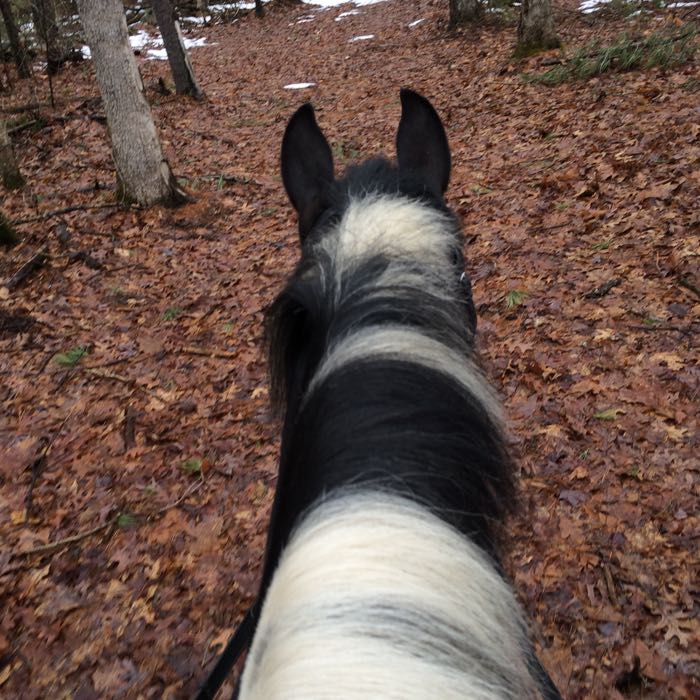
My favorite view of horse ears – looking forward to adventure.
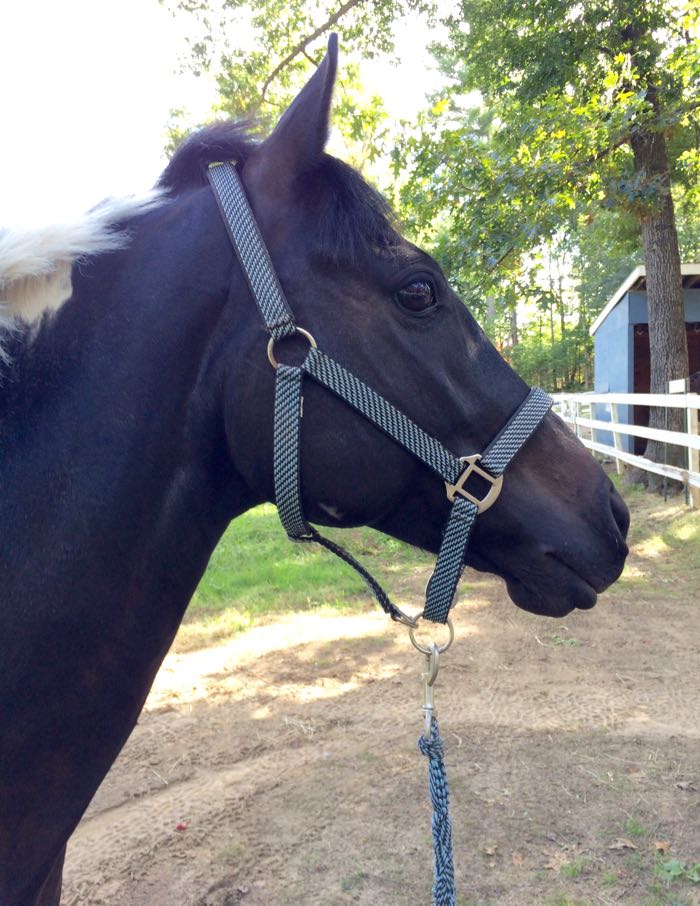
These ears are forward but worried. Tonka has alerted to a noise in the woods. Notice how tense the underside of his neck is held.
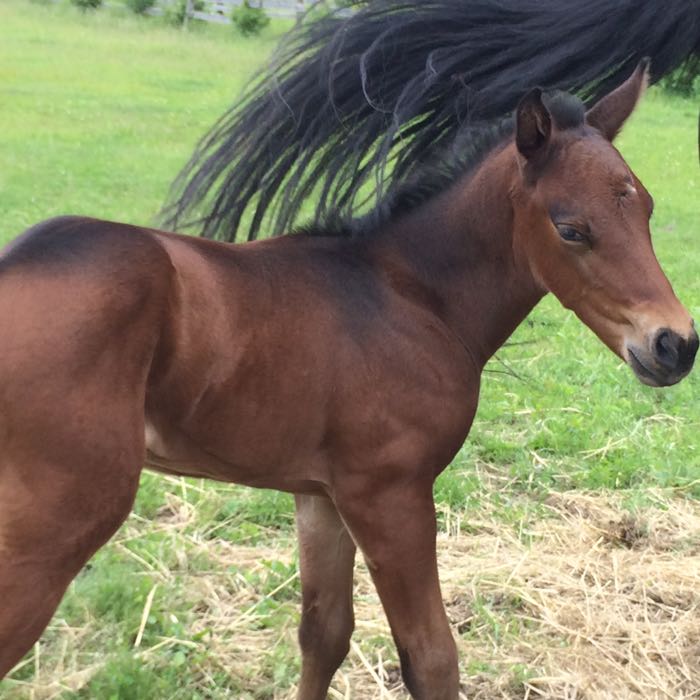
This foal is relaxed and has a sense of security, which is obvious from the position of the ears.
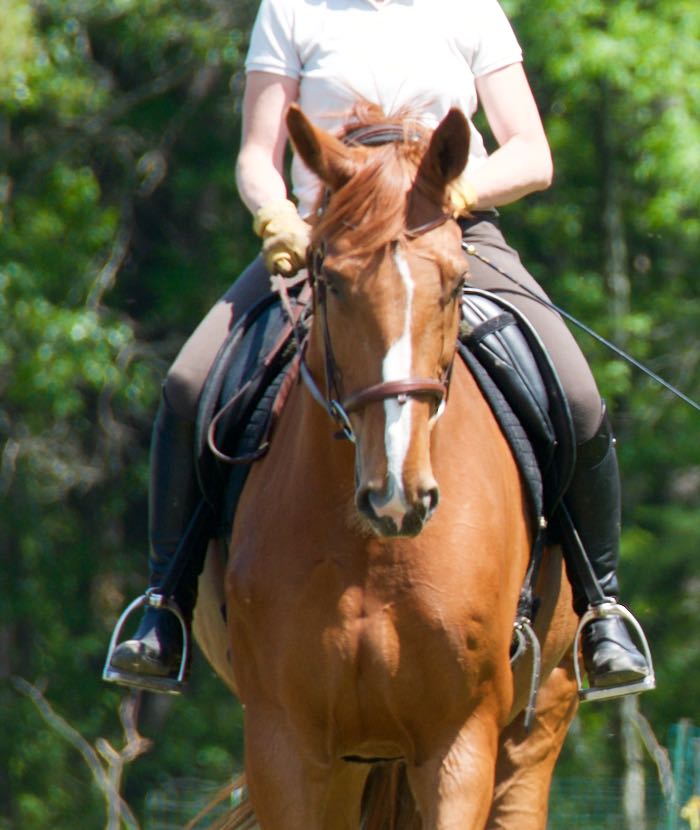
This horse has one ear on his rider and one ear paying attention to where he’s going. A nice attitude at the start of a trail ride.

Although these ears aren’t pinned tightly back, they do show annoyance and possibly discomfort.
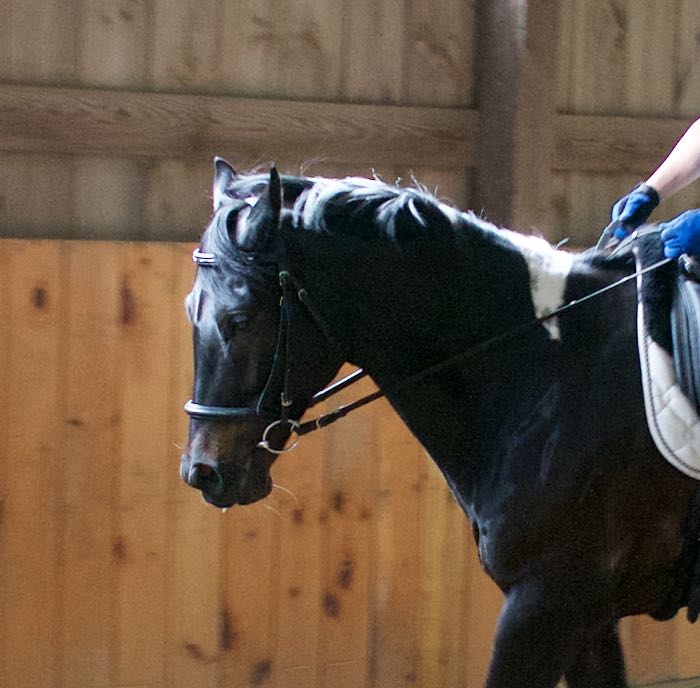
Tonka is clearly letting me know that what I’m asking of him is physically difficult.
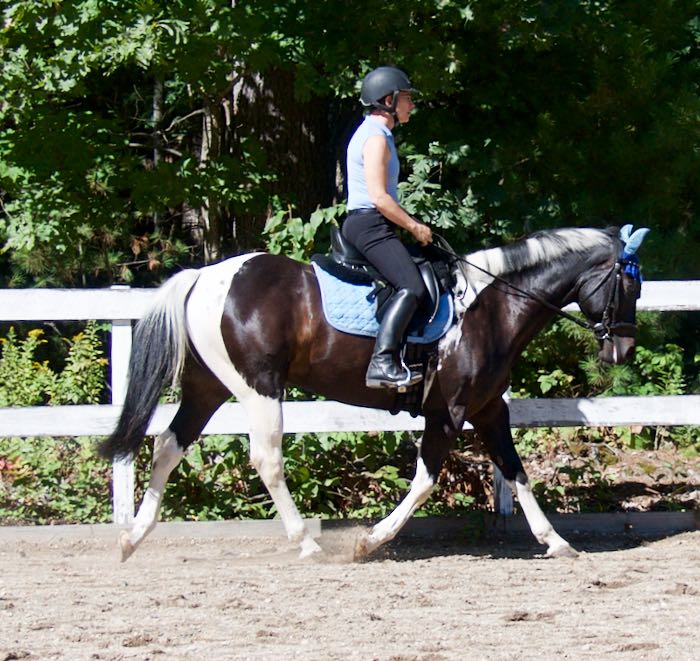
The trot that he was learning in the above photo is now easy and he can do the work forward and relaxed.
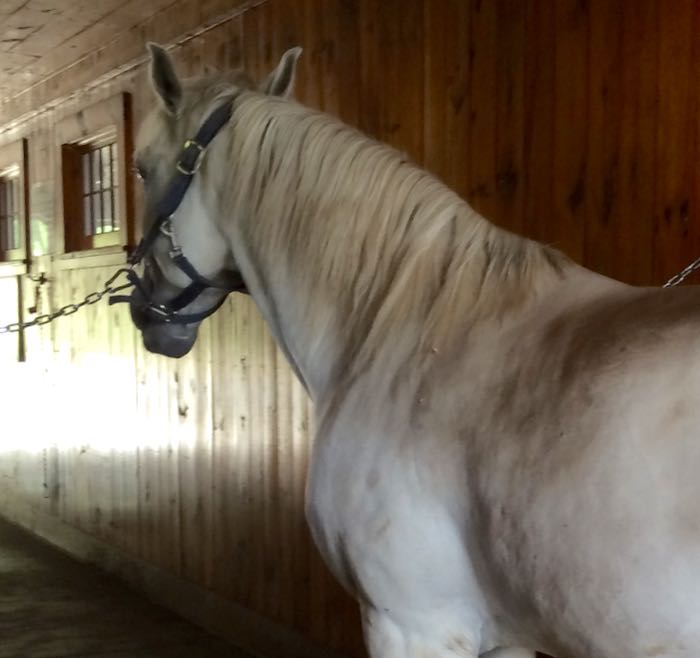
This Lusitano’s ears are pointed back, listening to the person behind him, but they’re not pinned. Sometimes ears just tell you what the horse is paying attention to.

This 29 year old mare was in need of a pasture friend. We introduced her to Tonka. At first, she looked pleased, as evidenced by the forward, eager ears.

However, Jasmine decided that she didn’t like Tonka in her space. She turned her tail to him, and Tonka got the message. Tonka is responding to her threat by pinned ears, but also by high-tailing it out of there. The horse next door is responding to the drama.
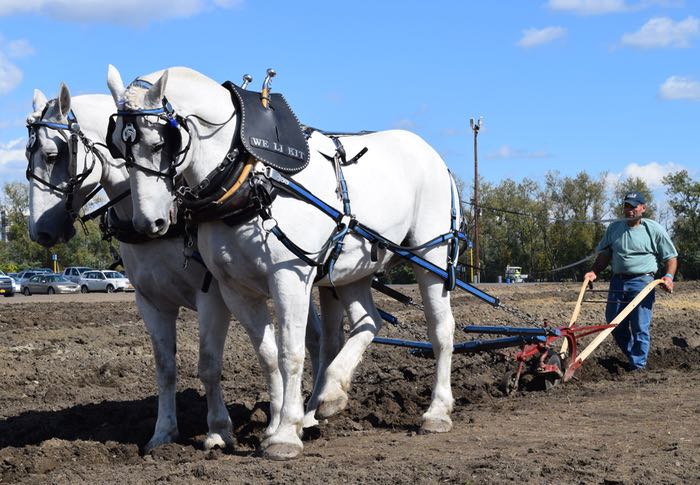
These ears are not pinned. The Percherons are working hard and listening to their owner’s verbal directions. I took a series of photos of this pair. Look at the next photo to see how they feel about their owner.

Finished with plowing, they look quite pleased with themselves. Their owner is approaching to give them a scratch and a treat.
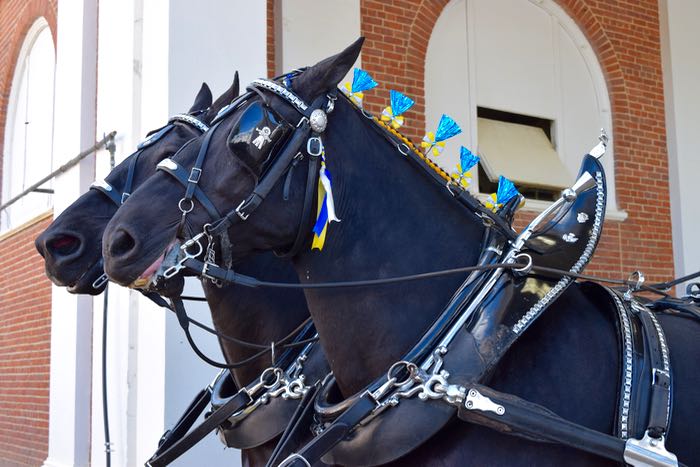
Contrast the above farm team with these horses. These ears are pinned, and they stayed that way as I watched them trot off.
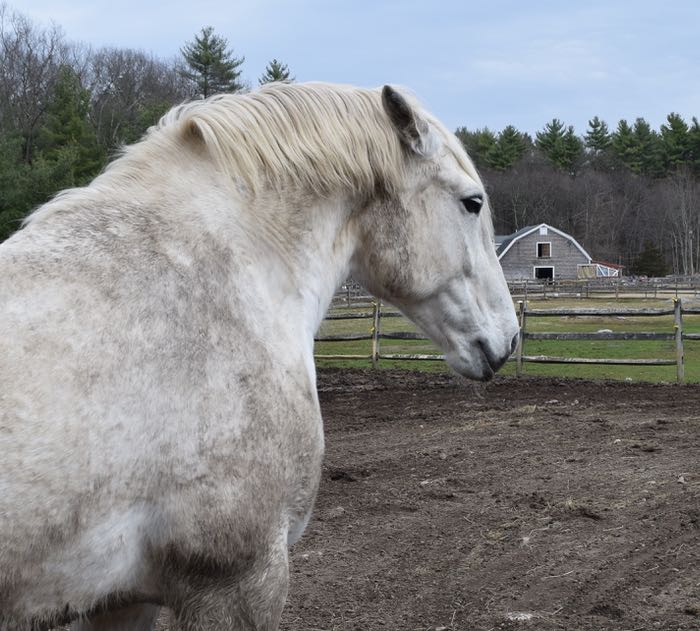
This mare is telling another horse to go away.
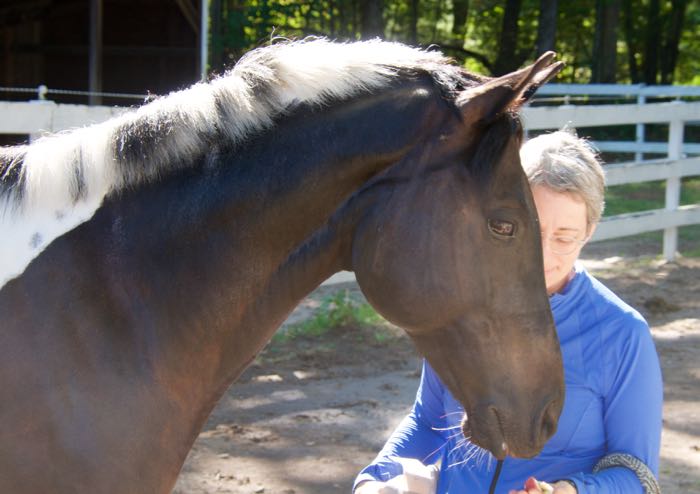
Tonka is eating apples from my hand with a relaxed and happy expression. This is the culmination of much preparatory work.
A big thank-you to Dr. Susan Friedman, who’s email conversation with me on this topic helped me to clarify what I’ve been thinking about for a long time; her prodding got me to put it into this blog. If you’ve been pondering similar training questions, I want to hear from you. Leave a comment or email me.

Thank you for taking time to publish your extensive knowledge of compassionate animal training. I have always loved animals and as long as I can remember have wanted to “talk” with them. You have made it very clear that it is imperative we learn their language first! I will keep this foremost in my mind when attempting to communicate with my dog, pond turtle, pond fish, box turtle and two guinea pig boars. Also I try to let all the lovely wild creatures around my home know that I am not a threat. Thank you for your hard work. You are a beautiful person and you make our world a beautiful place!
Thank you for saying that. I have a soft spot for guinea pigs. My first pet was a guinea pig named Chester and I had her for many years. So much personality in a small package!
WONDERFUL article! Too bad it we can’t make it required reading! And if I were those black horses in harness with that check rein crossed over my head with a bit (?) yanked up against my upper palate, I’d be permanently cranky too!
I knew one of my readers would see and recognized those check reins. Brutal.
Thank you for this very thoughtful piece. I particularly appreciate the instruction in ‘Horse Speak” as I am not a horse owner and have found the animals very difficult to read. I shall be watching the ears in future! Re. Tonka’s misgivings about clicker training, I had this problem with my little dog. Of course my technique was sub-optimal as I was new to it and teaching myself from Karen Pryor’s book (an actual human would have been helpful!), but then it dawned on me that as well as anything I was doing wrong, he didn’t like the sound of the clicker. He is a very sound sensitive little flower. I dumped it and made a tiny, delicate click with my tongue on the roof of my mouth – ever so quiet – and he was perfectly ok after that and training went swimmingly. I met a horse on the road the other day who was bucking and shying because a bit of litter was crackling in the ditch but she was perfectly ok after I got out of the car and picked it out. The owner said she didn’t like the noise it made. Just a thought.
Quite astute of you to realize that the sound was troubling your dog. Some people use the click of a ball point pen.
Brilliant article, a lot of thought and well written, how I wish I could still ride. The pair of black horses remind me of the film Black Beauty, when he and Ginger were harnessed up to the carriage and the woman kept wanting their heads held higher, how I hated that part of the film even though it wasn’t real it seemed it.
Black Beauty was written as a way to raise the public’s consciousness about horse abuse. A hundred years later, it’s still effective!
Great article, Terry. As a kid, I rode under a perceptive coach. Every time I got bucked off, she would brush me off and immediately tell me to “go apologize” to the horse. If I was nipped, she would empathize, then tell me to be sure “to apologize to your horse”. I recall complaining once that my horse would expand her lungs and diaphragm when I was trying to tighten the girth. Her response was “well, I’m sure you didn’t mean it, but I hope you’ve apologized to your mare.” She made me understand, very young, that when things go wrong with animals, it is always our fault. Always. To this day, when I see unwanted behavior in my animals, I slow everything down and go back to the most basic observations to try to decipher what I’m doing wrong. I’m always humbled by their forgiveness, in dogs especially. It’s an even more foreign language, horse-speak, and you touched on it so beautifully.
You had the BEST teachers. These days, tack shops are selling crops (horse term for whip) with sparkles and flowers and in pink – for little girls to hit their horses with. I wish that your teacher were still out there! Please share my post on whatever social media you are on. Let’s continue to get this message out.
Sounds like Tracy (above) had a great teacher like mine. In my very young years when I encountered that girth issue with my horse, I has an extensive lesson in proper use of aids….by having them all removed! We worked for weeks (on flat and over fences) without girth, then without stirrups, without reins, and eventually without saddle, so that I could better understand how each one was only a tool, but a tool that should be used very respectfully and sparingly. Being freed from relying on them changed my whole approach to horsemanship, and helped me understand my horse as an intelligent, feeling being. It also opened up avenues of communication that did not rely on “aids.”
Terry, thanks so much for this post. I agree that the horse is the most complicated and challenging of animals to work with, and I really like your musings on the role of the entirety of a horse’s stable-life and how it couches those precious hours we are able to spend with them. I look forward to reading more of your thoughts on this.
I have fond memories of riding jumping grids without reins or stirrups AND having to sing nursery rhymes! Keeps you breathing :)
A lovely and informative post. I never realised how expressive a horses ears are. I will look out for that in future when I see horses.
Terry, if you have not already seen this, you might enjoy watching Stacy Westfall’s 2006 American Quarter Horse Congress ride – – no tack, only horse and rider. I never get tired of watching that video, the perfect interaction between horse and rider.
Amazing to watch, thanks..:)
Unfortunately, her training techniques rely on a lot of flooding and aversives. There are others who do the demo circuit riding “at liberty” but, they too, train with techniques that don’t justify the end results. (Clint Anderson is one.)
Really! I was not aware of that. I am glad you responded to this to clarify. I hope you might create a post discussing this so that we “animal folk” can see some comparisons of the different methods side by side. That would be very interesting for those of us who have not been formally trained in animal teaching methods.
Thanks as always, Terry! Always very good info. :)
This was very educational; thank-you!!!
I have found dressage training to be very helpful with my 16 yr old Tennesee Walker. I have only owned him for a little over a year, but he has started to give us a spontaneous trot instead of his usual running walk! I credit the bending and suppleing that we do in dressage with his ability to get that swinging gait, and while I still enjoy his fabulous running walk, it sure is fun to be able to explore different gaits. Luckily I have found a fabulous trainer who has helped both of us tremendously!
I rode a TW in California and he was so comfy it was like sitting on a couch. So happy that you have a good trainer and that you are keeping your horse fit and supple. Autumn is the sweet spot for riding, isn’t it? Enjoy!
One final remark: Don’t you just love an earnest draft horse?
Beauty and purpose. Such a wonderful combination.
Love it Terry! Well written. We really need more attention paid to this and more studies. I have three horses and don’t have pinned ear issues in general but do have it for one particular behavior from my mare (who in all other regards is sweet as and never ‘pinny’) and that’s when she is following a target. She kind of pins and shakes her neck like she is going to kill it…:-) So…we don’t play that game anymore!! But I don’t know if it was how I trained it (badly) or if it is something about the behavior that generates the pinned ears. I guess I could try and re-train it to see if I could get sweet ears…?? Someone suggested it is a natural behavior because chasing a target it like sending a coyote out of the herd…??
It would be great to see more articles and video’s of some serious ‘pinners’ being rehabbed. I think for a lot of people it’s unclear how to address it.
Anyhoo, the other interesting topic you touched on was the geldings dropping. I also wonder when my mare is working in-hand and gets ‘nickery’ if that’s the equivalent of a gelding dropping. It’s really cute but my gut feeling is she is a little too excited about the behavior. We need more studies (and I need more horses :-)).
We all need more horses :)
I’ve a feeling that attacking the target has less to do with killing it (that’s more of a dog behavior – a horse would turn around and kick) but more to do with frustration. Unless she thinks that doing so gets her a cookie faster. There’s no one answer that fits all horses.
The gelding dropping issue (for those of you who don’t know what we’re talking about – a horse’s penis is usually out of sight in his sheath. Sometimes, he drops it out) is very complex. It’s as expressive as the ears, and it also should not be ignored. More on that another time!